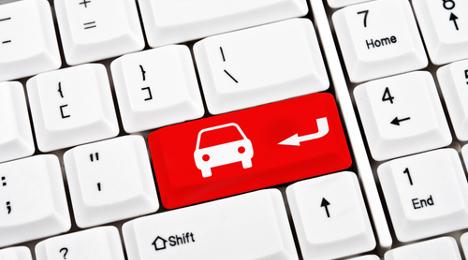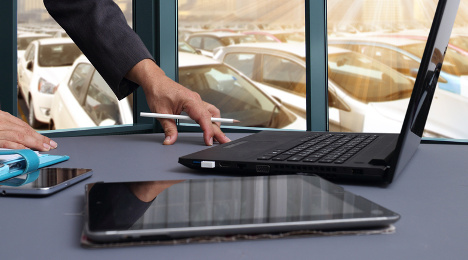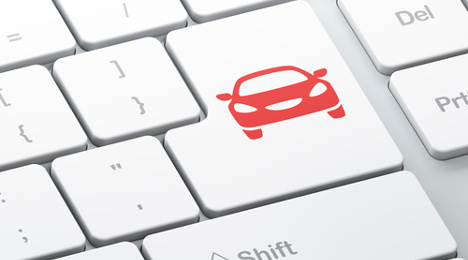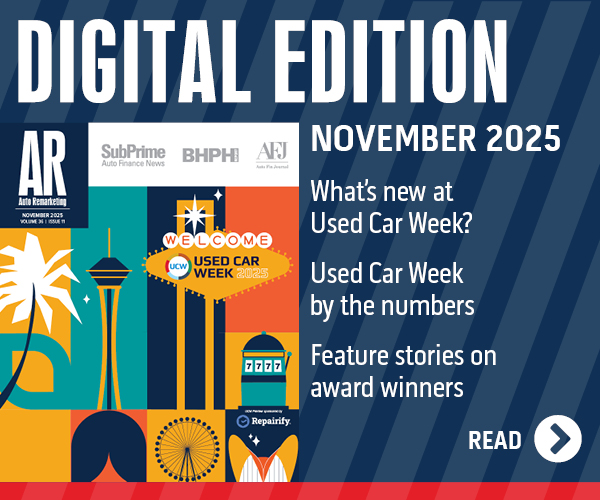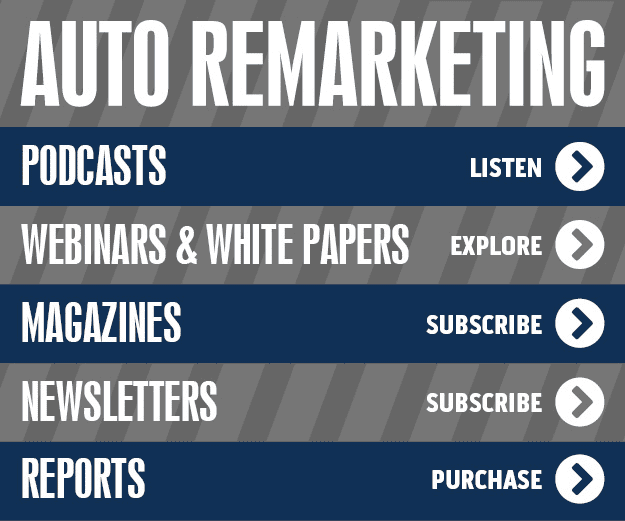Seeing an industry disruptor like Carvana file for an initial public offering isn’t necessarily something that gives Mark O’Neil pause.
Such momentum by an online retailer is perhaps a sign that consumers are heading toward the ecommerce route.
Getting away from the profitability aspect, folks gravitate to entities like Carvana “because they offer a process that addresses the pain points in the selling process,” says the Cox Automotive chief operating officer.
“It should be one more indication to the larger dealer community that if offered the opportunity to improve the process, the consumers are going to move to the retailer that offers the improved purchase process,” O’Neil said in a phone interview last week. “It doesn’t scare me, because honestly I think any dealer could replicate, if they’re committed to it, that same process.”
The dealer may not go the same route as Carvana has with things like vehicle vending machines, “but they can clearly the replicate the transparency and ease of transacting very easily,” he said.
“And I think more and more will,” O'Neil said. “I think as competition comes in and they see people moving to competitive models; dealers are very savvy local entrepreneurs, and if they sense there’s an opportunity in their market or they’re losing share in their market by not doing something, I think they’ll jump to it.”
In comments from O’Neil shared ahead of his speech earlier this month at the Automotive Forum in New York, he said that clicking a button to buy a car is not only the route that the auto wants to go, it’s also the route it should go.
“Click to buy is definitely where we want and need to go in automotive,” O’Neil said in the comments shared in a news release. “Success in retail can only be achieved by giving consumers options that enable the buying experience that they want.”
And that’s the heart of it, he said: it’s what the consumer wants. For most any other transaction a shopper makes, the online option is available.
“We are, as a society — and I’d say all generations — getting used to transacting retail purchases digital,” O’Neil said by phone.
Given the “friction” involved in some steps of the car-buying process (like the trade-in), many consumers would rather conduct parts of the process outside of the dealership. And if provided the chance, “”they’d wholeheartedly embrace it,” he said.
That speaks to their need for a self-directed process where they complete steps of car-buying in the order of their choosing.
A five-step process
Of course, buying a car (online or otherwise) is complex with a lot of moving parts, as O’Neil outlines below. There needs to be:
—A real, actual payment lined up
— Pre-approval from bank
— A “genuine” presentation of all the F&I presentation options, like protection plans, prepaid maintenance, key protection insurance and so forth
— A determination of how trade-in will come into play (i.e. figuring out how money-owed or equity will be considered as part of the deal)
— A method to handle paperwork digitally
At the moment, O’Neil said Cox Automotive is able to handle the first four of the five steps. By year’s end, it will start rolling out complete digital signature capabilities. They can provide that in-store through signing on a digital signature pad in a store, but in fourth quarter they’ll launch the capability to do it via keyboard.
“And I think once that whole seamless process exists — let’s think like Amazon checkout now — then I think we’ll see the adoption,” he said
One hang-up with complete digitization is with state departments of motor vehicles paperwork. Digitization of that paperwork is not universally available across the U.S.
“Because of DMV restraints, getting everything electronic — every single form — is just not going to happen for multiple years, but for most consumers, that’s completely acceptable,” he said. “I would say the vast majority of digital retail contracting for the next few years are going to have some part of the paperwork being signed the old-fashioned way,” largely because some state smay not have their DMV forms ready digitized.
It’s possible to automate most dealer and lender forms, he said. Digitizing DMV forms is something that Cox Automotive will have to “feather” into the solution over time.
Learn from other industries
In the aforementioned comments in the New York speech, O’Neil cites entities like Amazon, Domino’s, Rocket Mortgage and Zappos that have used technology to make a more efficient, transparent, customized and enjoyable buying process.
Cox Automotive argues that doing the same in automotive could bear similar results.
So, what can the auto industry learn from folks who have succeeded (or, conversely, not succeeded) in digital retail?
“I think the learnings from all these folks are, it needs to be intuitive. Whether you’re buying eyeglasses or ordering pizza, there’s no one there to guide you through the process,” O'Neil said. “So, you need to make sure you design your technology in a way is self-evident; it’s intuitive (for) the consumer to figure out themselves.”
The online option, he said, also has to provide additional value for the buyer. In other words, it has to save them time, be transparent and be self-directed/flexible.
Dominion Dealer Solutions announced on Thursday that Dominion Dealer Specialties has introduced LiveLot, a fully responsive video marketing platform that supplies auto dealers with full-service video marketing strategies and tools.
On the LiveLot mobile app, dealers can make and publish vehicle inventory videos with custom voiceovers, vehicle walkarounds and customer testimonials.
“In the past several years, the car buying process has transitioned from the brick and mortar showroom to the virtual showroom. In this more competitive environment, it is imperative that automobile dealers take full advantage of any opportunity to differentiate themselves from the competition and drive prospects to their physical locations,” Dominion inventory solutions general manager Shane Marcum said.
The new platform's dealer portal allows them to manage all of their video content in one location via a live dashboard that includes in-depth analytics for both consumer engagement and individual vehicles. Dealers can also build customizable landing pages for each of their videos.
“Our new feature-rich video offering, LiveLot, virtualizes the traditional selection and presentation steps of the 'road to the sale' and acts as an integrated part of the customer’s virtual showroom,” Dominion inventory solutions associate product manager Shelley Hoffman said. “By helping auto dealers with the shopping process, our video offerings drive prospects to the dealership lot who are engaged with the dealer’s sales team and ready to negotiate and close.”
Additionally, Dominion said each video is personally designed to maximize reach and enhance customer engagement.
For more information regarding LiveLot's offerings, visit www.drivedominion.com/livelot.
Car and Driver is now giving auto dealers the opportunity to place their inventory listings in front of an estimated 12 million-plus monthly online visitors through its website’s new inventory listings product that matches its online content and vehicle search capabilities with a dealer’s inventory.
“This product marks the beginning of Car and Driver’s evolution from an enthusiast-focused news and reviews website to a complete decision-making resource for in-market auto shoppers,” the automotive content brand’s partner, Jumpstart Automotive Media, said in a news release.
The new listings product not only gives dealers a platform to share listings on Car and Driver’s site that yields more than 12 million unique monthly visitors, but it also allows dealers to own all messaging, ads, and links on their vehicle detail pages.
“In turning ourselves into a true service for car shoppers and enthusiasts, we become a connection point between the consumer’s automotive curiosity/desire and the car itself,” Car and Driver editor-in-chief Eddie Alterman said. “While the function of our site is changing, our mission remains the same: to deliver the most useful, honest, and entertaining information about cars.”
Car and Driver’s new offerings are exclusive to the brand’s website and will be sold through Jumpstart’s dealer sales team, according to the marketing and advertising solutions company.
“Taking a mobile-first approach, we have completely re-architected the website. We’ve also doubled our editorial staff and increased the scope of topics to cover more of today’s trending topics such as technology and environment,” Josh Searcy, Car and Driver chief product officer said.
“Car and Driver’s evolution is in response to the disruption in the online auto marketplace; it’s about accommodating the ways people actually want to shop for cars online. We’re incredibly excited about how far we’ve come and what’s still yet to come in making the auto shopping experience more complete for our audience.”
Additionally, according to Searcy, alongside the suite of auto shopper tools now available — such as pricing and inventory — Car and Driver is currently developing a new buyer’s guide section that provides 9 in-depth categories for each make and model, as well as reviews.
The website of the multi-platform brand ran by TIME’s content and creative collective The Foundry — TheDrive.com — has added a new research and shopping page named SHOP, which instantly gives users access to the latest new and used-car data and connects prospective buyers with nearby dealers.
Currently, the new digital innovation integrated across The Drive’s network can offer car buyers data and online pricing for more than 300 makes and models.
“This initiative starts with the user’s needs at the core. With this new car research platform, users can start by reading feature articles about cars and car culture, then go from imagining themselves behind the wheel straight to pricing models and connecting with dealers,” Eric Goeres, general manager of The Drive, said in a news release.
“It’s car enthusiast catnip — doubly so for those in-market.”
On SHOP, not only can users find detailed information regarding vehicles’ make, model and trim, they can also both browse inventories and manage any of pricing and quote requests, according to TIME.
The newly integrated platform was built in collaboration with automotive digital media company Detroit Trading.
“We worked closely with management and brand leadership from Time Inc. and The Drive to develop an industry-leading automotive portal for its audience,” said Pete Bonner, co-Founder and executive vice president of Detroit Trading.
“We feel this new online resource, combined with real-time phone support from our Detroit-based segment specialists, will make the process of shopping for a new vehicle responsive, informative and, most importantly, fun! We work on a lot of cutting-edge projects at Detroit Trading, but we’re especially thrilled to be part of the exciting things happening at TIME and The Drive.”
TIME said The Drive users have access to an average of 4.5 million units of used vehicle inventory and one-click connections to an online dealer network spanning all 50 U.S. states.
“The deal comes at a time when the American auto industry just posted a record year in sales and is increasingly technology driven, with consumers doing more research online than ever,” TIME said. “The Drive pursues a younger, more mobile, more affluent audience with its broad scope of “new enthusiast” editorial coverage—an expansion of traditional horsepower, reviews and wrenching automotive journalism that includes future tech, policy, aviation, infrastructure, design, gear, military and entertainment and celebrity coverage.”
The Foundry launched The Drive in 2015, it publishes a wide range of editorial content to a mobile audience of young, tech-forward auto buffs, according to TIME.
The Drive YouTube channel has almost 2 million subscribers and its videos average 5 million views each month.
CarGurus launched the company’s inaugural mass-media awareness advertising campaign with two new television ads it debuted on Monday.
Over the next 12 weeks, the company said 30-second commercials are scheduled to air on network and cable television in the cities of Nashville, Tenn., Austin, Texas and Denver, in addition to a national YouTube campaign ad.
The three test markets were tapped to enable dynamic campaign measurement, according to the company.
CarGurus created two humorous ads, one titled Detective and the other, Guru.
The concept of the two ads is that while consumers may feel they need detective skills or a guru to overcome the complexities of the car shopping process, CarGurus makes it fast and easy.
“CarGurus helps millions of consumers find great car deals and connect with top-rated local dealers, but many car shoppers still haven’t heard of us,” Sarah Welch, senior vice president of consumer marketing at CarGurus, said in a news release. “We’ve built a compelling solution that simplifies the car shopping process, enabling consumers to save time and money. We are excited to test into a channel that gives us more room to tell that story.”
The car research and shopping platform announced it teamed up with advertising agency Plum14 and director Nick Spooner of The Sweet Shop and Chirp Films for creative development and production, and Ocean Media will manage media planning.
“The company will measure TV’s performance as a driver for brand awareness and incremental traffic acquisition to inform a longer term offline marketing strategy,” the company said. “CarGurus has no plans to scale back its investments in digital marketing channels, but rather will test mass media as a complement and hopefully an accelerator to its proven digital strategy.”
The TV ads and YouTube commercial can be viewed here and through the window at the top of this page.
When it comes to shopping online, consumers say Cars.com is the best automotive third-party desktop site and that Kelley Blue Book is the best mobile site, according to the J.D. Power 2017 U.S. Automotive Website Evaluation Study Cross-Device report.
The study examines which current site functions and designs car buyers say is most effective when researching vehicles.
J.D. Power evaluated automotive third-party websites overall site function and the relevance of multiple site features to online shoppers.
In January, the consumer insights provider surveyed 8,525 new and used-car shoppers who visited automotive manufacturer websites’ shopping for a vehicle within the next 24 months.
"Over the past five years, we've seen an explosion of innovation that has been employed by third-party automotive sites, among others, to guide automotive shoppers through the process," Thomas King, vice president of PIN OEM operations, media & marketing at J.D. Power, said in a news release. "However, in the end, it always comes back to content and we have found that the top-performing sites are better at delivering key information on different devices."
Following Cars.com as the top ranking desktop site is Edmunds, followed by Carfax.
CarGurus and The Car Connection trail Kelly Blue Book as the second- and third-ranked mobile sites.
Seventy-six percent of highly satisfied shoppers on third-party websites say they "definitely will" visit the website in the future, and 75 percent say they "definitely will" recommend the site.
Navigation, appearance, information/content and speed are the four website satisfaction areas the study analyzed.
Website satisfaction is lowest for navigation.
The study finds that car buyers on a desktop computer significantly enjoy their experience navigating automotive websites more than mobile users.
Desktop evaluations totaled 4,259 and mobile evaluations totaled 4,266.
To read more information about the study and its methodology, visit http://www.jdpower.com/resource/us-automotive-website-evaluation-study-cross-device.
Insurance Auto Auctions announced on Wednesday that it has adopted and launched an updated vehicle details page on IAAI.com to streamline customer access to vehicle information.
The new page has up to 320 additional VIN details and comprehensive Hollander Interchange parts data, which helps car buyers estimate vehicle value more quickly and make better-informed bidding and buying decisions, according to IAA.
"Our online tools are built for our customers, by our customers. Their feedback and needs are the primary drivers and designers of these enhancements," Jeanene O'Brien, IAA senior vice president of global marketing, said in a news release. "By streamlining the vehicle details pages, we are able to facilitate an unmatched buying experience and deliver better information and better value."
To improve the user experience IAA said the page has a newly unified layout and added mobile functionality.
The enhanced page also loads 60 percent faster and uses 50 percent less network data.
IAA said customers can now maximize their search time and more efficiently choose the vehicles they may want to bid.
Additionally, registered buyers get unique data. Certain information can be revealed or hidden depending on a customer’s individual needs.
"Delivering a differentiated customer experience through data and technology is a strategic priority for IAA," said John Kett, chief executive officer and president of IAA. "IAA provides our customers with rapid access to the most complete vehicle information possible, enabling them to bid and buy with greater confidence and convenience."
To view the newly enhanced page, visit https://iaa-auctions.com/vehicle-details.
Particular car shoppers respond better or worse to different words when debating which car to buy, according to new research released by CDK Global on Tuesday.
The company’s latest edition in its Language of Closers series provides demographic specific entail that is valuable to dealers seeking out ways to most effectively describe inventory on their vehicle description pages.
“Our research examined the words that would eventually lead buyers of different demographics to leave a review website and head to a dealership site,” Jason Kessler, lead data scientist at CDK Global, said in a news release. “In our most recent analysis, we were able to pinpoint specific words that shed valuable light on what vehicle traits matter most to women, Generation-X consumers, recent college graduates, and parents."
CDK found a number of words that it says resonate with multiple demographics heavily.
For example, the research revealed that mentioning the word "power" attracted several groups. CDK suggests it helps to illustrate the experience of driving a vehicle in a relatable way.
“Certain words fell flat and failed to lead prospective buyers to a dealership site,” the provider of integrated information technology and digital marketing solutions said.
Women responded negatively to “bigger,” Generation-Xers would rather read "performance" over "design" and most parents fell that both "sound" and "tech" were low priorities compared to others.
Below is a list of the top and low performing words associated with four demographics that CDK highlights.
WOMEN
Top: drive, power, trip, comfortable, luxury
Low: bought, transmission, owned, bigger, cargo
GEN-X
Top: truck, power, luxury, package, performance
Low: back, seat, design, built, difference
COLLEGE GRADS
Top: buy, work, truck, power, highway
Low: company, designed, inside, warranty, light
PARENTS
Top: truck, leased, row, nice, purchase
Low: sounds, buying, control, tech, company
"As a leading provider of websites and digital advertising for dealers and OEMs, we are always looking for the best ways to help our customers bring the right buyers into their dealership. By making subtle changes to the language used on vehicle description pages, dealers can help customers easily identify cars that they both connect with and fit their lifestyle needs," Kessler added. "Ultimately, these changes will prime both dealers and customers for success."
For more information about The Language of Closers, visit http://www.cdkglobal.com/promo/language-of-closers-reviews.
On Monday, Kelley Blue Book announced its first in a series of international launches with the introduction of Kelley Blue Book in Portugal at KBB.PT. According to a 2017 TGI Grupo Marktest study, price was the No. 1 important factor for both new- and used-vehicle shoppers in Portugal, with 74 percent of new-model buyers and 72 percent of used-unit purchasers indicating the importance of price in their decision.
Kelley Blue Book is the fourth Cox Automotive brand to join the Portugal market, with Manheim Portugal, which recently celebrated its 10-year anniversary, along with Incadea and Auto SAPO Venda Já.
“Kelley Blue Book’s expansion to Portugal is a testament to our 90-year history of providing car buyers and sellers with trusted vehicle values, fair pricing and automotive expertise to make well-informed purchasing decisions,” said Dan Ingle, vice president of international business development for Cox Automotive Media Solutions Group, which includes Kelley Blue Book and Autotrader.
“We’re confident KBB.PT will quickly become the market standard for vehicle pricing and valuations in Portugal, offering the industry and consumers effective transparency within the car market,” Ingle continued.
Built in partnership with Janela Digital, a leading supplier of technological solutions, Cox Automotive said KBB.PT is a completely re-envisioned web-based consumer and valuation platform. KBB.PT was created in collaboration with company partners in Portugal, who worked alongside its specialists in the United States, including data scientists, web designers and other in-house experts.
Kelley Blue Book insisted it will seek to replicate the consumer and valuations platform as it expands into other markets.
Visitors to KBB.PT will have free access to trade-in, private party, used-vehicle retail and new-model retail pricing. Specifically for the automotive industry, Kelley Blue Book Auction Values also will be available in an industry-facing software product coming to the Portugal market.
“Intended to address the need for a more sophisticated vehicle valuation solution in most markets around the globe — both from an industry and consumer perspective — we built a new multi-currency, multi-language vehicle valuation engine that can be adapted to other international markets,” said Nuno Castel Branco, business development director at Cox Automotive, parent company of Kelley Blue Book.
“We expect the development and architecture behind the new Kelley Blue Book Portugal platform to increase operational efficiencies when we launch in other territories,” Branco added.
For KBB.PT, Kelley Blue Book also partnered with Auto SAPO, a leading provider of automotive classified listings in Portugal, which will help provide classified pricing data in Portugal, one of a variety of data inputs used to fuel the valuations engine.
“For SAPO it is of utmost importance to partner with Kelley Blue Book, a leader in vehicle valuation and automotive research,” said Filipa Martins, director of SAPO. “SAPO’s partnership with Kelley Blue Book strengthens the offerings to the automotive industry in Portugal.
“Kelley Blue Book provides vehicle values, a needed service in the market, to help bring consumers and dealers closer together,” Martins continued. “Kelley Blue Book also provides vehicle research, news and advice, and information about auto shows through our dedicated area of the SAPO website, Motores, where users can navigate through the articles, as well as offers to sell or purchase a vehicle."
While consumers are more apt to visit stores on days that are warmer and drier — making it easier for dealerships to move inventory — a report recently released by The Weather Company showed that cooler temperatures and inclement weather more likely drive consumers to choose to stay home and want to do research online via their mobile devices or home computers instead of making that trip out to a showroom floor to scout potential purchases.
Because the vehicle-buying process is heavily influenced by weather conditions, the report suggested dealership marketers would greatly benefit from taking steps to implement a weather strategy the most optimally crafted to support their endeavors.
The Weather Company said its latest report is designed to analyze how much this summer’s weather is expected to impact auto buying.
“What we see is that most severe weather and precipitation have a larger impact in keeping consumers out of the dealers,” The Weather Company’s vice president of automotive sales Sarah Ripmaster said during a phone interview with Auto Remarketing.
This summer, dealerships can optimize their marketing efforts if their strategy is developed with the weather in mind, the report suggested.
“The research shows that this coming summer — based on our historical data — is looking to be a drier summer and cooler summer,” Ripmaster said. “While the summer may be cooler, it doesn’t necessarily mean that consumers will not be into the dealerships, it’s more about figuring out the mindset of the consumer during different conditions.
"Even if it’s cooler, consumers have high energy," she continued. "They’re creative even if they’re feeling a little bit cool. They are more apt to want to be in a more creative environment, they want to be spoken to in a different way than if it were really, really hot or really, really cold.”
The report indicated that 76 percent of drivers surveyed said weather conditions determine whether when they chose to visit a dealership.
“That’s a really high number, and it’s important for OEMs to consider when marketing,” Ripmaster said.
Weather not only impacts sales but consumers’ behavior as well, she suggested.
“Weather is one of the highest drivers of behavior linked directly to consumer behavior, 66 percent test drive their vehicle before they make a purchase this is no surprise,” Ripmaster explained.
“What’s important to note is that as you’re driving consumers down the purchase tunnel and you’re getting them close to the purchase — we know that consumers don’t test drive vehicles when weather is inclement, when there’s heavy precipitation or when it’s freezing cold.”
She said if marketers don’t take steps to deploy messaging that is created specifically to connect with consumers during particular weather conditions, they may be wasting ad dollars.
“It’s important to understand the link between weather and consumers purchase behavior when digitally marketing to this consumer,” Ripmaster said. “When we know that there is a rain storm coming, an OEM marketer may want to suppress advertising messages.”
The following lists three conditions the report cites as keeping consumers away from lots the most.
• Snow/Hail: 76%
• Extreme Cold: 51%
• Fog: 40%
In December, the weather data provider surveyed more than 1,400 adults, ages 18 and up on weather.com for more than three weeks. To view the report visit, go to this website.

